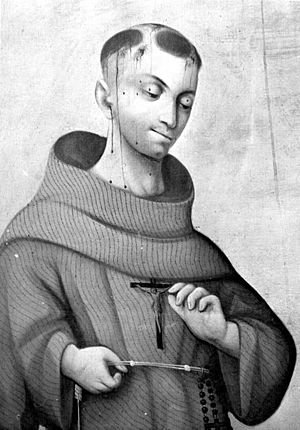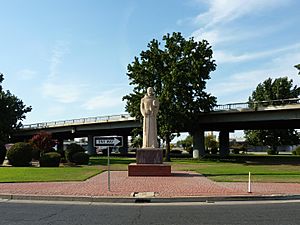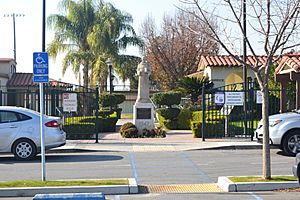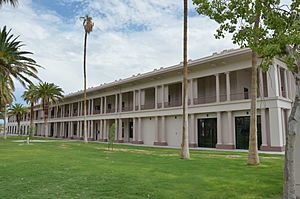Francisco Garcés facts for kids
Quick facts for kids
Francisco Garcés
|
|
|---|---|
 |
|
| Born | April 12, 1738 Morata de Jalón, Zaragoza, Spain
|
| Died | July 18, 1781 (aged 43) |
| Nationality | Spanish |
| Occupation | Franciscan friar, priest and explorer |
Francisco Hermenegildo Tomás Garcés (April 12, 1738 – July 18, 1781) was a Spanish Franciscan friar. He was also a missionary and an explorer. He worked in a part of the world then called New Spain. This area included parts of modern-day Mexico and the United States.
Garcés explored much of the southwestern part of North America. This includes areas like Sonora and Baja California in Mexico. He also explored Arizona and California in the U.S. He was killed along with other friars during an uprising by Native American people. The Catholic Church honors him and his companions as martyrs.
Contents
Who Was Francisco Garcés?
Francisco Garcés was born on April 12, 1738. His hometown was Morata de Jalón in Aragon, Spain. Around 1758, he joined the Franciscan Order. He became a priest in Spain in 1763.
Exploring New Spain
Garcés traveled to New Spain, which is now Mexico. He worked at the Franciscan college of Santa Cruz in Querétaro. In 1768, the King of Spain made a big change. He ordered the Jesuits to leave their missions. These missions were in northwestern New Spain. Garcés was one of the Franciscans who took their place. He was sent to Mission San Xavier del Bac. This mission was in the Sonoran Desert, near Tucson, Arizona.
Franciscan Missionaries in the Desert
The King's decision to remove the Jesuits led to many changes. Franciscans from Querétaro took over the missions in the Sonoran Desert. This area is now parts of Mexico and Arizona. Other Franciscans, led by Junípero Serra, went to the Baja California missions. These were in the lower Las Californias Province.
Garcés the Explorer
Garcés played a very important role in this new effort. He explored huge areas. These included the Sonoran, Colorado, and Mojave Deserts. He also explored the Gila River and the Colorado River. His journeys went from the Gulf of California all the way to the Grand Canyon.
He met and wrote about many Native American tribes. He learned about their homes in the desert and along rivers. He helped create peaceful relationships with them for Spain. These tribes included the Quechan, Mojave, Hopi, and Havasupai. Many of his journeys were solo explorations.
Garcés also joined soldier-explorer Juan Bautista de Anza on two big trips. In 1774, he went on the first expedition to reach California's Pacific coast from the east. In 1775-76, he joined the Anza Colonizing Expedition. This trip went as far north as San Francisco Bay. Garcés also crossed the Mojave Desert using the Mohave Trail. He then crossed the Old Tejon Pass and explored the southern San Joaquin Valley in 1776. Today, part of his route across the Mojave Desert is known as the Mojave Road.
His Death
Between 1779 and 1781, Garcés and Juan Díaz started two mission churches. These were Mission Puerto de Purísima Concepción and Mission San Pedro y San Pablo de Bicuñer. They were on the lower Colorado River at Yuma Crossing. This was in the homeland of the Quechan people. Garcés tried to keep peace among everyone.
However, the peaceful relationship with the Quechan people ended. Spanish settlers were said to have broken agreements with the native peoples. This led to problems like loss of crops and farmlands. In July 1781, Garcés, Díaz, and other friars were killed. This happened during a violent uprising at the Mission San Pedro y San Pablo de Bicuñer. It is known as the Yuma Uprising or Yuma Revolt.
Garcés' body was later moved to Mission San Pedro y San Pablo del Tubutama. The Catholic Church considers him and the other friars killed at these missions to be martyrs.
Garcés' Legacy
Francisco Garcés is remembered in several places.
El Garces Hotel
The El Garces Hotel is named in his honor. It is a historic train station and hotel built in 1908. It is located in Needles, above the Colorado River. Garcés passed through this area during his 1776 expedition. The hotel was built by the Santa Fe Railroad. It was known as the "Crown Jewel" of the Fred Harvey hotel chain.
National Forest
A place called Garces National Forest was created in southern Arizona. This happened on July 1, 1908. It included parts of other national forests. However, its name was changed in 1911. It became part of the Coronado National Forest.
Bakersfield, California
Garcés discovered the first Tejon Pass in 1776. This pass connected the Mojave Desert to the southern San Joaquin Valley. This area later became Bakersfield. Because of this, there are several landmarks in Bakersfield named after him. These include Garces Memorial High School, a Catholic high school. Also, on Chester Avenue, there is Garces Memorial Circle. It has a statue honoring Garcés.
Las Vegas, Nevada
In Las Vegas, Nevada, some of the original streets are named after famous explorers. One of these streets is Garces Avenue. It is named after Francisco Garcés.
Also, the St. Thomas Aquinas Cathedral in Las Vegas has a stained glass window. This window is dedicated to Fray Garcés.
See also
In Spanish: Francisco Garcés para niños




